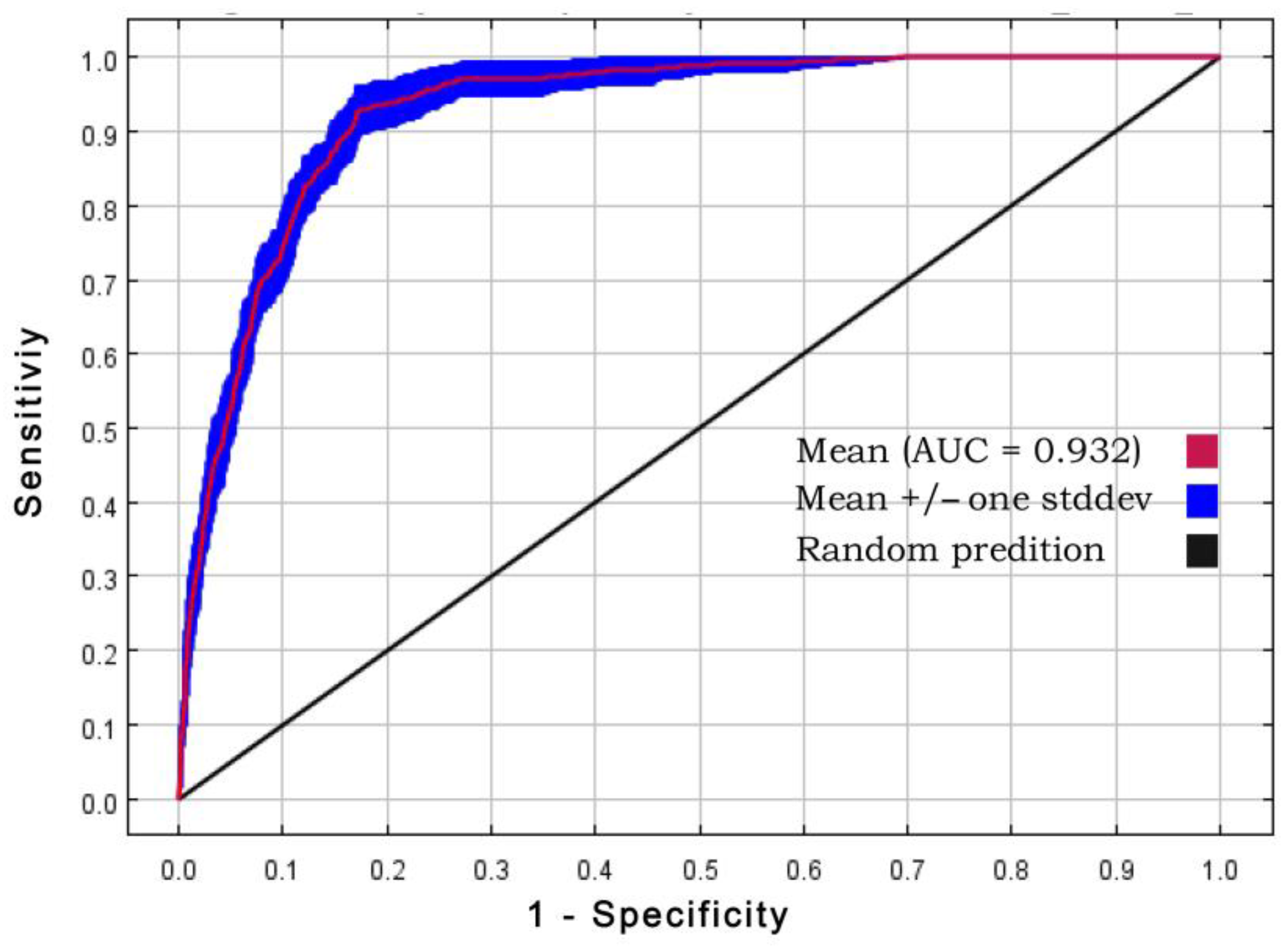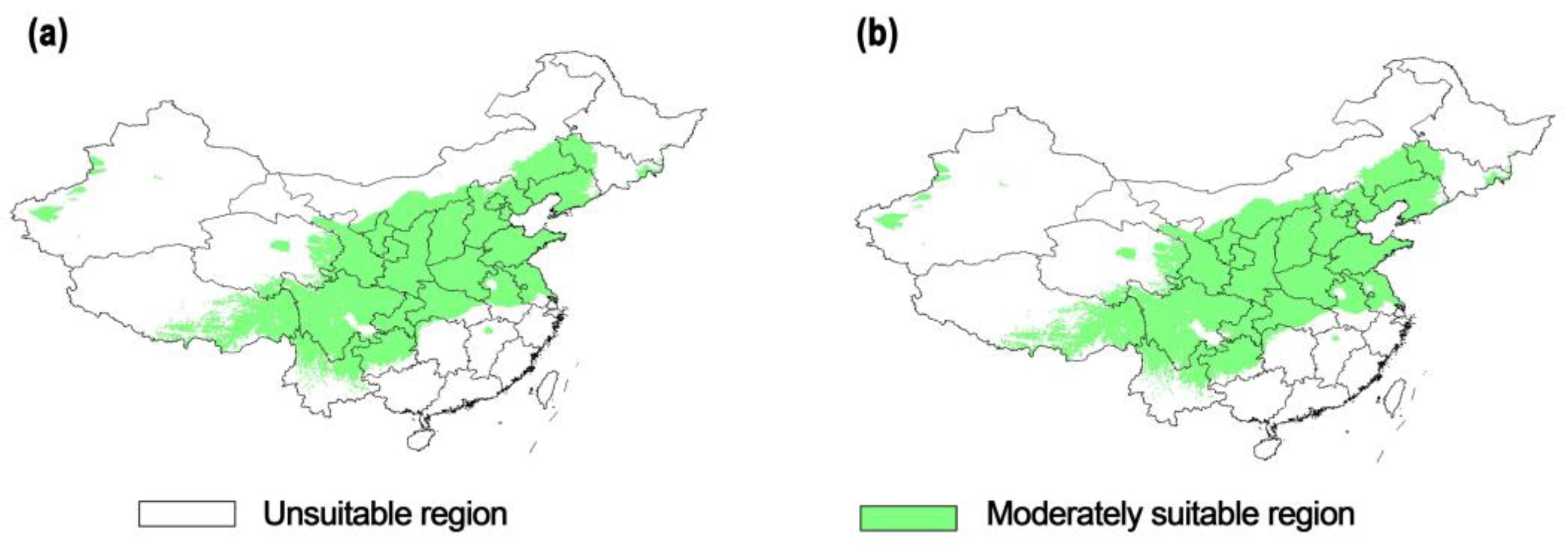Prediction of Potentially Suitable Distribution Areas for Prunus tomentosa in China Based on an Optimized MaxEnt Model
Abstract
:1. Introduction
2. Materials and Methods
2.1. Software Used
2.2. Species Distribution
2.3. Environmental Variables
2.4. Model Setting and Selection
2.4.1. Model Optimization
2.4.2. Model Building
2.4.3. Model Predictive Evaluation
2.4.4. Suitable Area Level Partition
2.4.5. Low Impact Area
3. Results and Analysis
3.1. Model Evaluation
3.2. Environmental Variables
3.3. Suitable Distribution Area
4. Discussion
4.1. The Impact of Model Complexity on Model Accuracy
4.2. Environmental Variables and Potential Distribution
5. Conclusions
Supplementary Materials
Author Contributions
Funding
Institutional Review Board Statement
Informed Consent Statement
Data Availability Statement
Acknowledgments
Conflicts of Interest
References
- Hamilton, E.; Maughan, T.; Black, B. Nanking Cherry in the Garden; Utah State University Extension: Logan, Utah, 2016. [Google Scholar]
- Lang, J.P.; Zhang, Z.J.; Zhang, Q.P.; Wang, X.J.; Bi, S.H. A preliminary report on water and soil conservation benefit and economic value of Prunus tomentosa. Soil Water Conserv. Sci. Technol. Shanxi 1995, 2, 25–26. (In Chinese) [Google Scholar]
- He, H.L. Genetic Diversity and Populations Genetic Structure of Wild. Prunus tomentosa in Northern China Using Simple Sequence Repeats (SSRS) Markers; Northwest A&F University: Shaanxi, China, 2015. (In Chinese) [Google Scholar]
- Wei, L.M.; Qin, Y.; Gao, B.Y. Development and Utilization of Prunus tomentosa Resources. Forest By-Prod. Spec. China 2017, 2, 87–88. (In Chinese) [Google Scholar]
- Wang, Y.S.; Xie, B.Y.; Wan, F.H.; Xiao, Q.M.; Dai, L.Y. Application of ROC curve analysis in evaluating the performance of alien species’ potential distribution models. Biodivers. Sci. 2007, 15, 365–372. (In Chinese) [Google Scholar]
- Martínez-Meyer, E.; Peterson, A.T.; Servín, J.I.; Kiff, L.F. Ecological niche modelling and prioritizing areas for species reintroductions. Oryx 2006, 40, 411–418. [Google Scholar] [CrossRef] [Green Version]
- Engler, R.; Guisan, A.; Rechsteiner, L. An improved approach for predicting the distribution of rare and endangered species from occurrence and pseudo-absence data. J. Appl. Ecol. 2004, 41, 263–274. [Google Scholar] [CrossRef]
- Honig, M.A.; Cowling, R.M.; Richardson, D.M. The invasive potential of australian banksias in south african fynbos: A comparison of the reproductive potential of Banksia ericifolia and Leucadendron laureolum. Aust. Ecol. 1992, 17, 305–314. [Google Scholar] [CrossRef]
- Garza, G.; Rivera, A.; Venegas-Barrera, C.S.; Martinez-Ávalos, J.G.; Dale, J.; Feria-Arroyo, T.P. Potential effects of climate change on the geographic distribution of the endangered plant species manihot walkerae. Forests 2020, 11, 689. [Google Scholar] [CrossRef]
- Carpenter, G.; Gillison, A.N.; Winter, J. Domain: A flexible modelling procedure for mapping potential distributions of plants and animals. Biodivers. Conserv. 1993, 2, 667–680. [Google Scholar] [CrossRef]
- Rong, Z.; Zhao, C.; Liu, J.; Gao, Y.; Zang, F.; Guo, Z.; Mao, Y.; Wang, L. Modeling the effect of climate change on the potential distribution of qinghai spruce (Picea Crassifolia Kom.) in qilian mountains. Forests 2019, 10, 62. [Google Scholar] [CrossRef] [Green Version]
- Costa, G.C.; Nogueira, C.; Machado, R.B.; Colli, G.R. Sampling bias and the use of ecological niche modeling in conservation planning: A field evaluation in a biodiversity hotspot. Biodivers. Conserv. 2010, 19, 883–899. [Google Scholar] [CrossRef]
- Phillips, S.J.; Anderson, R.P.; Schapire, R.E. Maximum entropy modeling of species geographic distributions. Ecol. Model. 2006, 190, 231–259. [Google Scholar] [CrossRef] [Green Version]
- Merow, C.; Smith, M.J.; Silander, J.A. A practical guide to maxent for modeling species’ distributions: What it does, and why inputs and settings matter. Ecography 2013, 36, 1058–1069. [Google Scholar] [CrossRef]
- Warren, D.L.; Seifert, S.N. Ecological niche modeling in maxent: The importance of model complexity and the performance of model selection criteria. Ecol. Appl. 2011, 21, 335–342. [Google Scholar] [CrossRef] [Green Version]
- Parolo, G.; Rossi, G.; Ferrarini, A. Toward improved species niche modelling: Arnica montana in the Alps as a Case Study. J. Appl. Ecol. 2008, 45, 1410–1418. [Google Scholar] [CrossRef]
- Zhu, G.P.; Yuan, X.J.; Fan, J.Y.; Wang, M.L. Effects of model parameters in max ent modeling of ecological niche and geographic distribution: Case study of the brown marmorated stink bug, Halyomorpha Haly. Biosafety 2018, 27, 118–123. (In Chinese) [Google Scholar]
- Yu, Y.Z.; Zhang, M.H.; Du, H.R.; Li, Q.; Zhang, L.B.; Mu, W.J. Optimized MAXENT model in simulating distribution of suitable habitat of moose. J. Northeast For. Univ. 2019, 47, 81–84, 95. (In Chinese) [Google Scholar]
- Xu, D.; Zhou, Z.; Wang, R.; Ye, M.; Pu, B. Modeling the distribution of Zanthoxylum armatum in China with MaxEnt modeling. Glob. Ecol. Conserv. 2019, 19, e00691. [Google Scholar] [CrossRef]
- Zhang, T.; Huang, Z.H.; Peng, Y.J.; Wang, Y.T.; Wang, P.; Wang, S.T.; Cui, G.F. Prediction of potential suitable areas of actinidia arguta in china based on MaxEnt model. Acta Ecol. Sin. 2020, 40, 4921–4928. (In Chinese) [Google Scholar]
- Swets, J.A. Measuring the accuracy of diagnostic systems. Science 1988, 240, 1285–1293. [Google Scholar] [CrossRef] [Green Version]
- Muscarella, R.; Galante, P.J.; Soley-Guardia, M.; Boria, R.A.; Kass, J.M.; Uriarte, M.; Anderson, R.P. ENM Eval: An R package for conducting spatially independent evaluations and estimating optimal model complexity for maxent ecological niche models. Methods Ecol. Evol. 2014, 5, 1198–1205. [Google Scholar] [CrossRef]
- Xu, Z.L.; Peng, H.H.; Peng, S.Z. The development and evaluation of species distribution models. Acta Ecol. Sin. 2015, 35, 557–567. (In Chinese) [Google Scholar]
- Poirazidis, K.; Bontzorlos, V.; Xofis, P.; Zakkak, S.; Xirouchakis, S.; Grigoriadou, E.; Kechagioglou, S.; Gasteratos, I.; Alivizatos, H.; Panagiotopoulou, M. Bioclimatic and environmental suitability models for capercaillie (Tetrao Urogallus) conservation: Identification of optimal and marginal areas in rodopi mountain-range National Park (Northern Greece). Glob. Ecol. Conserv. 2019, 17, e00526. [Google Scholar] [CrossRef]
- Ni, J. Impacts of climate change on Chinese ecosystems: Keyvulnerable regions and potential thresholds. Reg. Environ. Change 2011, 11, 49–64. [Google Scholar] [CrossRef] [Green Version]
- Radosavljevic, A.; Anderson, R.P. Making better maxent models of species distributions: Complexity, overfitting and evaluation. J. Biogeogr. 2014, 41, 629–643. [Google Scholar] [CrossRef]
- Anderson, R.P.; Gonzalez, I. Species-specific tuning increases robustness to sampling bias in models of species distributions: An implementation with maxent. Ecol. Model. 2011, 222, 2796–2811. [Google Scholar] [CrossRef]
- Zhang, T.J.; Liu, G. Study of methods to improve the temporal transferability of niche model. J. China Agric. Univ. 2017, 22, 98–105. (In Chinese) [Google Scholar]
- Jiang, D.B.; Fu, Y.H. Climate change over china with a 2 °C global warming. Chin. J. Atmos. Sci. 2012, 36, 234–246. (In Chinese) [Google Scholar]
- Zhang, J.Y.; Li, Y.; Wang, Y.T.; Li, Z.Y.; Huang, C.R. Impact of climate change on geological disaster in southwest china. Plateau Mt. Meteorol. Res. 2020, 40, 70–77. (In Chinese) [Google Scholar]
- Li, X.H. Analysis of Thermal and Precipitation Resources in Northeast China under Greenhouse Gas Emission Scenarios; Shenyang Agricultural University: Shenyang, China, 2019. (In Chinese) [Google Scholar]
- Wei, J.F.; Li, X.Z.; Lu, Y.Y.; Zhao, L.; Zhang, H.F.; Zhao, Q. Modeling the potential global distribution of phenacoccus madeirensis green under various climate change scenarios. Forests 2019, 10, 773. (In Chinese) [Google Scholar] [CrossRef] [Green Version]
- Gao, B.N.; Qin, Y.; Wei, L.M. The advantages of planting multifunctional fruit tree Prunus tomentosa in cold regions. Agric. Technol. 2017, 37, 40. (In Chinese) [Google Scholar]
- Gao, Z.X. Popularization and application of drought—Resistant afforestation techniques for Prunus tomentosa. Inner Mong. For. Investig. Des. 2015, 38, 72–115. (In Chinese) [Google Scholar]
- Lindner, M.; Maroschek, M.; Netherer, S. Climate change impacts, adaptive capacity, and vulnerability of European forest ecosystems. For. Ecol. Manag. 2010, 259, 698–709. [Google Scholar] [CrossRef]







| Variable | Description | Contribution (%) | Permutation Importance (%) |
|---|---|---|---|
| Bio5 | Max temperature of warmest month/°C | 4.7 | 5.8 |
| Bio2 | Mean diurnal range/°C | 0.8 | 1.2 |
| Bio12 | Annual precipitation/mm | 1.4 | 6.3 |
| Bio13 | Precipitation of wettest month/mm | 1.6 | 3.9 |
| Bio8 | Mean temperature of wettest quarter/°C | 0.5 | 9.2 |
| Bio11 | Mean temperature of coldest quarter/°C | 56.9 | 50.5 |
| Bio15 | Precipitation seasonality/mm | 1.4 | 3.8 |
| Bio18 | Precipitation of warmest quarter/mm | 21 | 3.3 |
| Bio19 | Precipitation of coldest quarter/mm | 11.7 | 16.1 |
| Climatic Scenarios | Predicted Area (unit: × 104 km2) | |||
|---|---|---|---|---|
| Total Suitable Area | Low Suitability Area | Moderately Suitable Area | Highly Suitable Area | |
| 1960s–1990s | 345.70 | 189.28 | 130.55 | 25.87 |
| RCP4.5-2050s | 463.48 | 277.93 | 157.68 | 27.86 |
| RCP4.5-2070s | 512.57 | 305.11 | 178.04 | 29.42 |
| RCP8.5-2050s | 514.98 | 307.00 | 177.20 | 30.78 |
| RCP8.5-2070s | 584.87 | 352.84 | 199.21 | 32.83 |
Publisher’s Note: MDPI stays neutral with regard to jurisdictional claims in published maps and institutional affiliations. |
© 2022 by the authors. Licensee MDPI, Basel, Switzerland. This article is an open access article distributed under the terms and conditions of the Creative Commons Attribution (CC BY) license (https://creativecommons.org/licenses/by/4.0/).
Share and Cite
Fang, B.; Zhao, Q.; Qin, Q.; Yu, J. Prediction of Potentially Suitable Distribution Areas for Prunus tomentosa in China Based on an Optimized MaxEnt Model. Forests 2022, 13, 381. https://doi.org/10.3390/f13030381
Fang B, Zhao Q, Qin Q, Yu J. Prediction of Potentially Suitable Distribution Areas for Prunus tomentosa in China Based on an Optimized MaxEnt Model. Forests. 2022; 13(3):381. https://doi.org/10.3390/f13030381
Chicago/Turabian StyleFang, Bo, Qian Zhao, Qiulin Qin, and Jie Yu. 2022. "Prediction of Potentially Suitable Distribution Areas for Prunus tomentosa in China Based on an Optimized MaxEnt Model" Forests 13, no. 3: 381. https://doi.org/10.3390/f13030381
APA StyleFang, B., Zhao, Q., Qin, Q., & Yu, J. (2022). Prediction of Potentially Suitable Distribution Areas for Prunus tomentosa in China Based on an Optimized MaxEnt Model. Forests, 13(3), 381. https://doi.org/10.3390/f13030381





